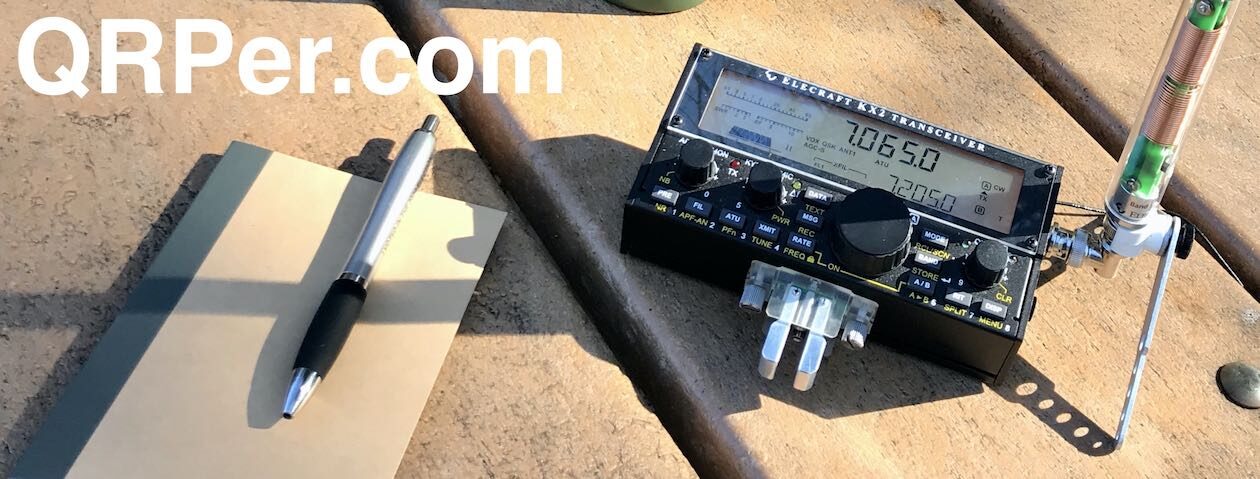 Many thanks to Carolanne (N0RNM) who shares the following guest post:
Many thanks to Carolanne (N0RNM) who shares the following guest post:
A Booty Boss Micro Radio Kit
by Carolanne Fisher N0RNM
I am a bit of a tinkerer and an aspiring POTA activator, so when I received my Elecraft KX2 a couple of weeks ago with its way-too-big carry bag, I immediately started to think about ways I could keep the KX2 protected on the trail in a much lower-profile, light-weight, and easy-to-carry kit that would always be ready to go. The trick was to find a case of just the right size, with plenty of built-in organization and flexibility to build the kit around. I found what I hoped would be exactly what I was looking for from the excellent Red Oxx Manufacturing company (redoxx.com) — a soft-sided compact bag they call the Booty Boss Waist Pack. At least the specs looked good…

I am certain that whoever designed this bag did it specifically with the KX2 in mind. It is small enough to take anywhere, yet it fits my entire setup, including the radio, an extra battery pack, an AX1 antenna, complete with its 40 meter extension coil, 2 counterpoises, along with other necessities perfectly. I printed and spiral-bound a small note pad, shoved in a few accessories, and I was ready to rock and roll. The bag is even lightly padded for a bit of peace of mind. I am a CW-only kind of op so a mic is not a concern, especially since if I absolutely needed to use phone, the KX2’s built in mic would serve perfectly fine.

I tested the bag during several “back-porch activations” and everything seemed to work great. That is until I tried to use it under more realistic conditions — without the shaded picnic table to deploy on and the comfortable chair to sit on. Sitting on a rock while balancing the radio on my knee with its floppy AX1 antenna, and note pad while actually tying to send code proved to be a bit more than I could handle. It was clear that something like a clipboard was necessary to complete the micro radio kit, but a normal-sized clipboard would completely break the one-tiny-bag ethos.
A couple of years ago I designed and 3D printed a portable folding easel to support my sketchbook, watercolors, water etc. when out and about nature journaling or urban sketching. It worked great for that so I made a smaller version, added a recess for the radio and made sure it had room for the notepad. In order to fit in the bag, the size, even when opened to its full 8” x 9.5” size is a bit cramped, but with the addition of a leg strap, like a pilot’s lap desk, it it does the trick.

Here is everything currently in the bag and how it all gets stowed:
Front zip pocket
- 13’ and 33’ counterpoises for use with the AX1
- An extra 28.5’ random wire antenna with 50’ of mini throw line attached (fly fishing backer line with two 1 oz. fishing weights) along with a 17’ counterpoise
Front main compartment
- Folded radio desk
- Note pad
- Pencil
Two small interior pockets
- Binder post
- Spare KX2 Battery
Interior zip pocket
- Spare set of paddles w/ KX2 attachment and cord (by Peter GM0EUL)
- Spare pencil
- Copy of my radio license
Rear main compartment
- Ax1 antenna (whip, 20 and 40 meter coils) lying the bottom
- KX2 (fits in the bag with the KXPD2 paddle attached)
Large slip pocket
- Ear phones

The KX2 fits flat on its back or up on its kick stand in its custom sized recess. A sticky gel pad (from Amazon) placed in the recess pretty much “glues” the rig to the desk until you want to remove it.
Although I don’t use it all that often, the AX1 is my all-purpose, quick-to-set-up and a snap-to-put-away antenna. I mount the bipod inboard to the radio (over the BNC connection) so it fits on the desk to provide support. I wedge the bipod out from the rig with a spare pencil or a stick from the trail placed between the rig and the front leg to take some of the twist pressure off the BNC connector.
Although the micro radio kit holds everything I need to make contacts, there are plenty of times that I like to have a more luxurious set up — a folding chair and table, my Alex Loop antenna, tripod, lunch, iPad, etc. Or perhaps I’m off for a multi-day and need an external battery, a solar charging system, food, shelter, etc. This scenario is precisely where the micro radio kit really comes into its own. It is tiny enough to slip into just about any bigger bag or placed on the waist belt of a backpack. No more wondering if you remembered this or that bit of radio kit or loosing track of things you borrowed from another kit. If you actually did forget something extra you thought you packed, not to worry, the micro radio kit has everything you need right inside to make contacts.
As a tiny everything necessary, nothing extra radio bag, the Booty Boss micro radio kit is, well, the BOSS!
– Carolanne (N0RNM)
Thank you so much for sharing this, Carolanne! As you know, I’m a massive fan of Red Oxx gear and also own the Booty Boss. It’s simply brilliant that you can even pack a folding radio desk inside! Thank you so much for sharing your field radio kit with us.




